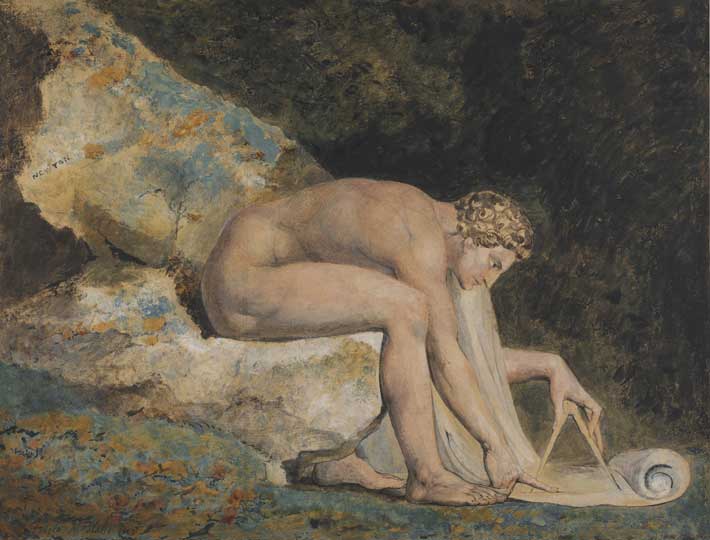‘William Blake: Apprentice and Master’ is in equal measure an illuminating and frustrating exhibition. In order to provide a full professional biography of his subject, Michael Phillips has brought together over 90 of Blake’s most important works along with nearly as many contextualising pieces again – apprenticeship and commission documents, contemporary prints, paintings, books, and so on. There is even, in a bid for yet more literal context, a full-size reconstruction of the printing studio at Blake’s home in Lambeth. Taken in one viewing it is, to put it mildly, a lot to take in.
There can be little argument with the quality of the works on show: the jewel-like coloured plates from the illuminated books, large prints such as Nebuchadnezzar and Newton, smaller etchings like the Laocoon, and Illustrations to the Book of Job, as well as less well known works like the large tempera panel illustrating the prologue to The Canterbury Tales. With the range represented, even Blake aficionados are likely to meet something new, and in the flesh, the quality of the colour washes, or the fine details and textures of familiar works thrill in a way that reproductions cannot match. The much smaller selection of works from the few disciples who gathered round Blake in his final years – the ‘Ancients’ – also contains some gems, with Edward Calvert’s woodblock prints from the 1820s standing out.
It’s hard to argue Phillips’ desire to replace Blake firmly in the world he belonged to. He might have been a maverick, a mystic, and probably a certifiable madman, but Blake remained a money-making professional printer for his entire working life. He underwent the same training as hundreds of other apprentices, competed in the same marketplace for jobs and commissions, and, despite declaring that ‘Where any view of Money exists Art cannot be carried on, but War only’, he succeeded in having a career. And as Phillips’ scholarly curation suggests, his works can only be understood with some knowledge of their production circumstances and techniques.
The problem is that such knowledge is hard won stuff, and there is a lot of it. This exhibition attempts to give a detailed account of Blake’s childhood, training and career, his religious affiliations, his relationships with friends, patrons, and followers, as well as crash courses in the history of (by my count) four different printing processes, before moving on to Blake’s own innovations, and their symbolic significance in his works. Inevitably, what makes it to the gallery wall by way of explanation is both too much and too little detail: a succession of facts without the necessary connective tissue to bring them together, let alone to life. Even the most inexhaustible viewer is likely to leave with as many questions as answers.
This is undeniably one of the most meticulously researched and curated exhibitions of recent times, and the catalogue (which fills many of the exhibit’s lacunae) is likely to be a major port of call for future students of Blake. But standing at the door of the reconstructed studio I had a sensation that expanded to the whole show: that for all the meticulousness, a vast amount was missing. A weirdly spotless simulacrum, the tiny room walled off in its gallery corner serves only to impress upon one the fact that you are not looking at Blake’s studio at all. Despite the printing tools and press, carefully arranged to look as if put down mid-print, I was left thinking that the spot-lit Job print hanging above the fireplace is the only thing Blake could possibly recognise as in any way his own.
‘William Blake: Apprentice and Master’ is at the Ashmolean Museum, Oxford, until 1 March 2015
